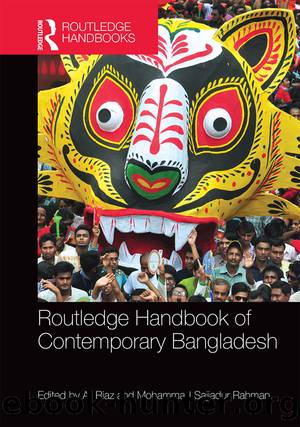Routledge Handbook of Contemporary Bangladesh by Riaz Ali; Sajjadur Rahman Mohammad;

Author:Riaz, Ali; Sajjadur Rahman, Mohammad;
Language: eng
Format: epub
Publisher: Taylor and Francis
Beneath the macro picture: micro-level ups and downs
The macro data presented in the earlier sections, while illuminating, do hide an important part of the reality. They do not tell us that during a particular period, when many people escape poverty, many non-poor households may simultaneously descend into poverty. An escape from poverty today is no guarantee of a life free of poverty; reversals are part of the harsh reality for many Bangladeshis living at the margin.
Sen (2003) provides a fascinating portrait of such dynamics based on a panel data-set for two points in time, 1987â1988 and 2000. The 21-village study, covering 379 rural households, suggests a drop in the poverty headcount ratio from 57 to 49 percent over this period. This is consistent with the macro-level findings from the HIES data for the same period.
However, as Sen observes, âWhile the incidence of poverty in general has declined there are winners, losers, and âbreak-evenâ households.â Some 119 households (about 31 percent of the sample) were poor in both time periods; this is the âalways-poorâ category. At the other end of the spectrum, 95 households (25 percent) classified as ânever-poorâ were above the poverty line in both periods. The two intermediate categories saw fluctuating fortunes, in one case for the better and in the other for the worse. Sen terms the first the âascending householdsâ. The 98 households in this category (26 percent of the sample) escaped poverty during this time. The other group, the âdescending householdsâ, were non-poor in 1987â1988 but, by 2000, these 67 households (18 percent) had slipped below the poverty line. The net poverty reduction rate is thus 8 percent, roughly consistent with aggregate poverty measures for the same period.
The above findings are instructive. They suggest that higher rates of poverty reduction can be achieved if steps are taken to prevent vulnerable householdsâ descent into poverty. In the above study, 28 percent of the households were able to escape poverty over a 12-year period. This gross rate of poverty reduction (28 percent) is significantly higher than the 8 percent net reduction in the poverty rate observed in the sample villages and the roughly similar rate of overall poverty reduction in the country during the same period.
The study provides important clues on how to prevent such declines. First, income growth obviously matters. The study found that the âalways-poorâ group had an annual per capita income growth of only 0.4 percent, compared to 10.4 percent for the group that escaped poverty. In explaining these stark differences, Sen makes a distinction between âcapabilityâ and âopportunityâ. The former is assessed in terms of initial levels of asset (land) ownership. The study found that in the low-wealth group (i.e., those owning up to 0.2 hectare of land), 53 percent of the non-poor households subsequently became poor, while only 39 percent of the poor households escaped poverty. In contrast, for the high-wealth group (owning 1.01 hectare of land or more), only 32 percent of the originally non-poor households slipped into poverty while 63 percent of the poor households went above the poverty line.
Download
This site does not store any files on its server. We only index and link to content provided by other sites. Please contact the content providers to delete copyright contents if any and email us, we'll remove relevant links or contents immediately.
| Africa | Americas |
| Arctic & Antarctica | Asia |
| Australia & Oceania | Europe |
| Middle East | Russia |
| United States | World |
| Ancient Civilizations | Military |
| Historical Study & Educational Resources |
The Story of China by Michael Wood(908)
Mr. Selden's Map of China by Timothy Brook(757)
Philippines--Culture Smart! by Culture Smart!(643)
Heroic Hindu Resistance To Muslim Invaders (636 AD to 1206 AD) by Sita Ram Goel(641)
Akbar: The Great Mughal by Ira Mukhoty(635)
The Meaning of India by Raja Rao(617)
Vedic Physics: Scientific Origin of Hinduism by Raja Ram Mohan Roy(607)
Banaras by Diana L. Eck(600)
India--Culture Smart! by Becky Stephen(587)
Food of India by unknow(585)
China Unbound by Joanna Chiu(581)
Mao's Great Famine: The History of China's Most Devastating Catastrophe, 1958-1962 by Frank Dikötter(576)
North of South by Shiva Naipaul(563)
Insurgency and Counterinsurgency by Jeremy Black(550)
First Platoon by Annie Jacobsen(548)
How to Be a Modern Samurai by Antony Cummins(546)
A History of Japan by R.H.P. Mason & J.G. Caiger(546)
The Genius of China: 3,000 Years of Science, Discovery, and Invention by Robert Temple(541)
The Digital Silk Road by Jonathan E. Hillman(529)
